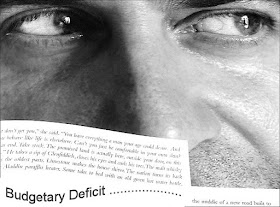What is Budget Deficit ? Types of Budgetary Deficit - India Trends
 What is a Budget Deficit ? Meaning ↓
What is a Budget Deficit ? Meaning ↓
When the government expenditure exceeds revenues, the government is having a budget deficit. Thus the budget deficit is the excess of government expenditures over government receipts (income). When the government is running a deficit, it is spending more than it's receipts.
Image Credits © Alex Grech.
The government finances its deficit mainly by borrowing from the public, through selling bonds, it is also financed by borrowing from the Central Bank.
 Types of Budgetary Deficit ↓
Types of Budgetary Deficit ↓
The different types of budgetary deficit are explained in following points :-
1. Revenue Deficit
Revenue Deficit takes place when the revenue expenditure is more than revenue receipts. The revenue receipts come from direct & indirect taxes and also by way of non-tax revenue.
The revenue expenditure takes place on account of administrative expenses, interest payment, defence expenditure & subsidies.
Table below indicate revenue deficit of the central government of India.
From the above table it is clear that revenue deficit was Rs. 18,562 crores in 1990-91 and Rs. 94,644 crores in 2005-06. As proportion of GDP, revenue deficit increased from 1.5% in 1980-81 to 3.3% in 1990-91 and declined to 2.7% in 2005-06. The decline is due to the passing of the Fiscal Responsibility and Budget Management Act in 2002.
2. Budgetary Deficit
Budgetary Deficit is the difference between all receipts and expenditure of the government, both revenue and capital. This difference is met by the net addition of the treasury bills issued by the RBI and drawing down of cash balances kept with the RBI. The budgetary deficit was called deficit financing by the government of India. This deficit adds to money supply in the economy and, therefore, it can be a major cause of inflationary rise in prices.
Budgetary Deficit of central government of India was Rs. 2,576 crores in 1980-81, it went up to Rs. 11,347 crores in 1990-91 to Rs. 13,184 crores in 1996-97.
The concept of budgetary deficit has lost its significance after the presentation of the 1997-98 Budget. In this budget, the practice of ad hoc treasury bills as source of finance for government was discontinued. Ad hoc treasury bills are issued by the government and held only by the RBI. They carry a low rate of interest and fund monetized deficit. These bills were replaced by ways and means advance. Budgetary deficit has not figured in union budgets since 1997-98. Since 1997-98, instead of budgetary deficit, Gross Fiscal Deficit (GFD) became the key indicator.
3. Fiscal Deficit
Fiscal Deficit is a difference between total expenditure (both revenue and capital) and revenue receipts plus certain non-debt capital receipts like recovery of loans, proceeds from disinvestment.
In other words, fiscal deficit is equal to budgetary deficit plus governments market borrowings and liabilities. This concept fully reflects the indebtedness of the government and throws light on the extent to which the government has gone beyond its means and the ways in which it has done so. in 1980-81, fiscal deficit was Rs. 7,733 crores. Between 1980-81 and 1990-91 it increased 5 times to Rs. 37,606 crores. Since the introduction of economic reforms in 1991-92, the government has tried to restrict the growth of fiscal deficit. As percentage of GDP fiscal deficit declined from 6.2% in 2001-02 to 4.1% in 2005-06.
4. Primary Deficit
The fiscal deficit may be decomposed into primary deficit and interest payment. The primary deficit is obtained by deducting interest payments from the fiscal deficit. Thus, primary deficit is equal to fiscal deficit less interest payments. It indicates the real position of the government finances as it excludes the interest burden of the loans taken in the past.
Table below indicate primary deficit as a Percentage of GDP.
Primary deficit of the central governent of India was 16,108 crores in 1990-91, it reduced to 14,591 crores in 2005-06.
5. Monetised Deficit
Monetised Deficit is the sum of the net increase in holdings of treasury bills of the RBI and its contributions to the market borrowing of the government. It shows the increase in net RBI credit to the government. It creates equivalent increase in high powered money or reserve money in the economy.
 Conclusion ↓
Conclusion ↓
All these budgetary deficit reveal fiscal imbalance. Fiscal imbalance & budget deficit result in harmful consequences like mounting inflation, deficit in balance of payment, etc. It has also adversely affect the growth of the economy. The government must introduce fiscal correction policies to overcome the deficit budget and fiscal crisis.



No Comment Yet
Please Comment